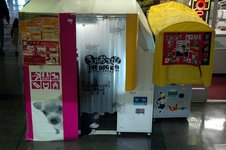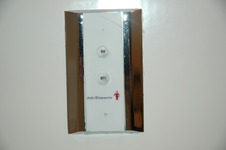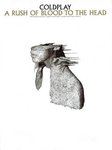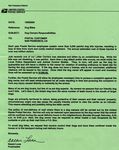 |
| Angelika/Mike Schilli |
Angelika Everybody knows San Francisco's Chinatown. Even those who have never visited San Francisco are familiar with this Asian district through many films. Who could forget the chase scene in the classic "What's Up Doc?" through the Chinese New Year parade? Even though today's "Chinatown" has probably too many cheap and kitschy souvenir shops, it still remains a must-see for every tourist, and we too enjoy strolling through the narrow, colorful streets.
Very few tourists, on the other hand, wander into Japantown. Recently, however, some travel guides must have featured the district, which we've noticed because there are now tourists -- armed with the aforementioned travel guides -- sitting in our favorite Japanese restaurants and bravely consuming Japanese food.
The charm of Japantown is only revealed to the visitor on second glance. At first glance, it is no more than a large shopping mall -- squeezed between the Miyako Hotel and the Kabuki cinema, surrounded by the Geary, Post, Fillmore and Laguna Streets.
In Figure 1 you can see that the street signs in Japantown are bilingual: On top it says "POST", which is typical in America, because the word for street ("Street") is never on the sign, unlike in Germany. It's clear that it's a street. Americans don't like unnecessary redundancy. The small sign with "1600" and the arrow to the right indicates that the house numbers start from 1600 to the right of the sign. To the left of it, they are lower.
Below it is the Japanese sign. On it are four Japanese characters. The left three are "Katakana" characters, which are used to phonetically sound out foreign words in Japanese. The first three characters are pronounced "Po-Su-To". Since Japanese people don't know hard consonants without vowels, "Post" is not easy to pronounce. That's why vowels are simply added to the "S" and "T" in "Post", because "Su" and "To" are common Japanese syllables.
Just to let you know: The three Katakana characters do not mean "Post" in Japanese. They only phonetically sound out the English word, which sounds a bit strange, but that's how Japanese people speak English. By the way, when Japanese people pronounce "Yahoo!", it almost sounds like "Yafoo!", although not quite, as the sound is somewhere in between "hoo" and "foo". On with the Japanese street sign, though: The fourth character is in Kanjii, yet another character set, it's pronounced "machi" and it symbolizes "Street". By the way, should you ever get invited to a party or quiz show, you can boast that you know that all Japanese Kanjii characters are identical to Chinese characters, but are pronounced very differently than in China.
Japantown's architecture is actually quite ugly, since the two shopping malls, named "Kintetsu" and "Miyako", were built in a bit of a modernization frenzy in the late 60s, to which many Victorian houses fell victim. Lots of concrete, little design. This also weighs on the so-called "Peace Plaza", which lies between the two malls, with its pagoda (also made of concrete) and a modern fountain. But if you want to discover a piece of Japan in San Francisco, or, like us, have a weekly longing for the land of the rising sun, head to "Nihonmachi". That is the Japanese word for Japantown: With "Nihon" (or Nippon), the Japanese are known to refer to their own country Japan.
Before the Second World War, San Francisco's Japantown was much bigger. The internment of Japanese living in America during the Second World War abruptly ended this. Since Japan had allied with Germany at the time and attacked the West in Pearl Harbor, President Roosevelt issued Order 9066 in 1942. All citizens of Japan living on American soil (even those with American citizenship) were forced to live in internment camps such as "Manzanar" (Rundbrief 12/2001). After their release, most Japanese did not get their homes back and, as a result, did not return to their familiar neighborhoods.
Despite all this, one can still find stores in Japantown today that have been in family ownership for generations. "Soko Hardware" is one of them. Here you can find not only typical DIY items such as cables, tools and paint buckets, but also original Japanese goods such as rice cookers, sushi knives, tatami mats and Japanese crockery. For months, they had a high-tech toilet on display in the window, which we already knew from our trip to Japan (Rundbrief 06/2002). Michael was overwhelmed and wanted to buy it. I could only barely stop him.
The stationery store "Kinokuniya" is again one of my favorite stores. I have always had a passion for good writing pens and the store carries hundreds of them. Already in my tender school age there was nothing better for me than the brand new Geha felt-tip pen package. I admit it openly: the Japanese know how to make good pens. And so I stand dreamily in front of the pen shelves and try one after the other, while Michael shifts from one foot to the other. The eponymous, associated book store, representing a well-known Japanese bookstore chain, is directly opposite the pen paradise. It not only carries a huge selection of literature, magazines and comics ("mangas") in Japanese language but also books on all possible Japanese and Asian topics in English.
"Ichiban-Kan", the Japanese version of a "dollar store", is also very popular with us. Here, you can buy all kinds of knick-knacks, from chopsticks to Japanese sweets and snacks to cosmetics. Recently we discovered our favorite drink Gokuri (Rundbrief 06/2002) there at a bargain price. The drink is also hard to get in San Francisco's Japantown. As is always the case in such stores, the grapefruit drink was quickly sold out.
Our main activity on our visits to Japantown is of course to indulge our culinary palates. If we are in the mood for a Japanese soup with Udon (thick white noodles) or Soba (thin buckwheat noodles), we frequent "Mifune".
If the line at "Mifune" is too long again, we'll stroll over to "Sapporo-Ya" whose specialty is ramen noodles (more Chinese-style). When we have guests who are new to sushi, we take them to "Isobune", where the sushi is placed on small boats swimming around in a circle right in front of you - so you can wait until something you might like is floating by just take the plate off the boat that you dare to eat. The sushi chefs are in the middle and prepare raw fish specialties on rice at lightning speed and with great dexterity. Many insiders in San Francisco say that the quality of the sushi at "Isobune" is rather average. But it's still fun.
Now comes the absolute secret tip, which you hopefully keep to yourself: "Takara", where you can get excellent Japanese home cooking. In our humble opinion, "Takara" offers the most authentic food - including the service: Michael and I usually always order a special lunch, where you can choose three bites of Japanese delicacies from an extensive list. But when Michael once ordered a mackerel, a salmon and a schnitzel, the waiter rolled his eyes in indignation and almost refused to accept the desired order. Twice grilled fish; that was too much for his Japanese soul.
After lunch, if you still have a craving for something sweet or bread in German style, take a stroll to Andersen Bakery (Rundbrief 12/2003). This branch of the bakery from Hiroshima, founded by a Dane, does not offer Japanese delicacies, but European style bakery goods. When looking at the baked goods, we always think we are in a German bakery (just without the rolls). Andersen's cheesecake also is unbeatably good.
Unless you're just eating dinner right now, please take a look at the swollen foot in Figure 6. I really couldn't walk anymore, every step hurt like someone was drilling into my ankle with a knife.
Where I work, at home or at the office, doesn't matter much, so the next morning I just called the office and requested a week of working from home. We have a super-elegant armchair at home, with a footrest that pops out when you lean back, and equipped with a laptop and a wireless network, it was really a pleasure to work like that. But after a few days, when my foot didn't get better, I started to get anxious. Maybe I should get an X-ray done?
The problem is, of course, that hospitals in the US are a nightmare. I believe the doctors there wouldn't find a fracture, even if it was marked with a thick red felt-tip pen on the X-ray. Sure, you can get a quadruple bypass or maybe have your brain taken out and put back in without any problem from super specialists, but everyday care is like in the third world.
My aversion to going to the doctor in America is already legendary: Last year, while Angelika was traveling, I pulled a roughly 1 cm long wood fiber into my finger with an careless hand movement while installing a computer cable under my desk, directly below the nail. The fiber couldn't be grasped with tweezers, it had slipped too deep under the skin. It was Saturday and I would have had to drive to the emergency room of the hospital, which was right around the corner, but in a rather, uhm, vibrant part of town. I had been there once before on a different occasion, and during my approximately one hour stay, a person with gun shot wounds had been wheeled in, blood-soaked. I'm no wimp, but I'm not going to the emergency room again anytime soon.
Finally, I drank a large glass of whiskey, heated up a needle, sprayed disinfectant on it, and slit the skin below the fingernail. It took about half an hour until, after several attempts, I finally managed to grab the splinter with tweezers. My victory yell could be heard all the way to the hospital.
Furthermore, after any visit to a doctor or hospital, one often has to struggle with the health insurance for months. Because hospitals have to treat people without insurance or means at least inadequately, and often remain stuck with the costs, they ruthlessly exploit people with insurance. When the insurance companies then refuses to pay those exorbitant amounts charged, the patient has to argue with rude and merciless debt collectors employted by the hospitals.
Besides, our health insurance requires an annual deductible of $250 (as Angelika already explained in Rundbrief 11/2004). With my new job since the end of September, I didn't have the new health insurance for long and was faced with the question: Should I pay $250 to get an X-ray of my ankle? But in the end, I broke down and ended up going to the doctor. He sent me to the hospital for an X-ray, where nothing was found. Well, at least I was reassured, that was worth the money.
When seeing a doctor, we only pay a deductible of $15, and our health insurance covers everything else. Not so with hospital services like X-rays: the health insurance only pays 90% and, as I said, I as a patient have to chip in $250 annually.
Figure 7 shows the bill that came by mail after my visit. The hospital actually charged $526 for the X-rays. Probably the X-ray machine was made of gold. In column B you can see that the insurance had previously negotiated a maximum of $341.90 with the hospital for X-rays of the ankle, and that is the amount that the hospital gets. If I wasn't insured, the hospital would have coldly charged me $526. In column E you can see the co-payment of $250 that your humble narrator unfortunately had to pay out of pocket. Of the $341.90, therefore, $91.90 remain, of which the health insurance reimburses 90%, and I was left with another $9.19. So we sent a check for $259.19 to the hospital and the matter was settled. Aetna, our healthcare insurance, is one of the better insurances and there were no complications. Well, that was one expensive Formula 1 curve!
Michael Every day, while riding my bike across the grounds of Lockheed Martin to Yahoo!, I notice a signboard with the updated terror alert scale at the gatekeeper's. It ranges from "Low" (green), to "Guarded" (blue), "Elevated" (yellow), "High" (orange), to "Severe" (red). For months, the pointer has been in the middle at "Elevated".
This warning system was released by the Department of Homeland Security, an institution newly created by President Bush.
The system is reminiscent of the fire warnings in American forests. There are usually signs with fields in four different colors, "Low" (green), "Medium" (yellow), "High" (orange), "Extreme" (red). And the forester sets a pointer to the corresponding field every day, depending on the weather, so that people know when the forest is bone dry and it is best not to light a campfire. Quite sensible.
But the terror warning system? During the Cold War in the seventies and eighties, at least recommendations were issued on what to do if, for example, an atomic bomb hits (head in the sand, newspaper on top!). But what should I do if the terror warning shifts to orange? To red even?
The satirical newspaper "The Onion" immediately came out with a warning sign for Iraq afterwards. The lowest warning level there was "Dull explosions in some distance". And a bit further up was the warning level "Let me put it this way; I wouldn't take any long drives."
Michael Living in America, you definitely see a lot more great deals to purchase stuff. A new PC from Dell with Intel 2.8 Ghz and 512MB RAM and 17 inch LCD screen for $575? No problem. However, such things are always only available for a few hours somewhere, often only online, and one would have to be constantly on the lookout to get wind of it.
Luckily, there are websites like slickdeals.net and dealcatcher.com, where volunteers scour around and report the latest special offers from competing stores. Does Dell have a coupon for a free printer, does Amazon have a Friday offer, or does the computer giant Comp-USA have a router that costs $17 and you get a $20 mail-in-rebate (see Rundbrief 01/1999)? You can find out on these sites. After reading it in the morning, you then have to decide quickly and order online, then you can get the most incredible deals. I have already bought 200GB hard drives for $59, wireless routers for $20 and, as I said, top-of-the-line computers with flat screens for $575.
No doubt: The stores sell these items at a loss. This is legal in the US. Of course, they expect customers to flock to the store or browse the website to order more than just the special offers.
But especially in Silicon Valley, a group of so-called "El Cheapos" has emerged, who rush into the stores on Saturday mornings to grab the bargain offers (and nothing else). And I know this from some colleagues who earn in the top 10 percent of the income scale -- it's just about the bargain.
Partially, you can see auctions on eBay offering items that were undoubtedly purchased from one of the supermarkets in Silicon Valley: If you look closely at the pictures, you can see original packaging with price tags from Silicon Valley retail giants like "Fry's". To redeem the mail-in rebate (Rundbrief 01/1999), the barcode has usually been removed from the packaging. Then, the eBay seller paid $20 for a DSL router at Fry's, received a $20 mail-in rebate from the manufacturer (Dlink, Belkin, Airlink), and then sells the item on eBay for $30 to a customer in South Dakota, who is happy to get it at that price. Everything 100% legal and a win-win situation for all consumers!
Moreover, it leads to a different buying behavior: People no longer buy a product because they need it, but because it is currently cheap. This of course keeps the economy going, which incidentally has recovered in the US since the recession and is on the brink of a new boom, and you're reading it here first!
For example, there is the website woot.com, a small startup company founded by a few immigrants from India to the USA, which offers one product per day and generates millions of dollars. The selection is completely crazy, one day it's a food processor, the other day a network router or a watch. The stuff is available as long as the stock lasts, then it's over for the rest of the day and the website just sits there idling. Until the next day, when the next Woot! Special offer goes on sale. By the way, the name of the company is derived from the phrase "Woot! There it is!", which can be translated as "Swoosh, there it is!".
Or take TiVo, as another example: On December 17th, 2004, they launched an advertising campaign. It was announced in papers that anyone who stood at a certain spot in Silicon Valley at 10am would get a digital video recorder worth $200 for free. The campaign was a huge success - thousands of people lined up and more than 1000 devices were given away. Helicopters from all the TV stations were there, newspaper reporters, the story was on everyone's lips and even some Yahoos skipped work until noon. When you consider how little publicity you'd get for $200,000 otherwise, it was a huge success.
Those who know me are aware that I like to take long and hot showers and steam up the bathroom like there's no tomorrow, but I've never produced a fog like this before. Full 10 sauna points from me for this product!
Michael Although already two years old and from Great Britain, I only recently discovered it and was enthralled: Coldplay's second album (after "Parachute"), "A Rush of Blood to the Head" strikes a quiet tone, but the melodies stick in your head: Recently I kept humming the refrain of "Politik" for an entire day. The tune reminds me of the band "The Alan Parson's Project" which I used to appreciate a lot, although you "No-Dialtoners" probably don't know what that is. By the way, in the U.S., "No-Dialtoners" are people who were born around 1990 and have never heard the dial tone on the phone because they only use mobile phones where there is no dial tone. Should I admit that I even remember that there used to be no continuous tone when you picked up the receiver, but rather an intermittent beep? Ugh, ugh, my bones!
Otherwise, I'm listening to "Depeche Mode" day and night. During the eighties, I always thought they were too commercial, but nowadays I find songs like "World in Your Eyes" simply stunning. And even "New Order" is being played on the radio all the time now. And recently, there's are all of these new remixes coming out, they seem to be the hit in the discotheques, but unfortunately I'm already too old for that. I'd rather not be greeted by "Hey, what's the grandpa doing here?"
Actually, this punishment is still too mild. Unfortunately, it happens again and again that dogs go crazy because their irresponsible owners let them run around unleashed. It has happened to me more than once that the dog of some idiot suddenly ran after my bicycle. The good thing in America is of course that you can really let off steam with the irresponsible person and call them anything you want. As long as you don't get physical, everything is allowed. The first amendment of the constitution guarantees it.
There is actually hardly anyone in Germany who reports on the USA in an informed and balanced way. Two extremes stand out: On the one hand, the "Huzzah!"-shouters, mostly well-situated entrepreneurs, who annoy everyone in Germany and idealize American conditions. At the other end of the scale are the America-haters, who have never been to the USA, but know how to tell horror stories about the "American Way of Life".
Our newsletter is trying to find a balance. We live in the USA, but we're not ignoring the problems.
The book "American Conditions" by Olaf Gersemann, which I recently read in English, where it is called "Cowboy Capitalism: European Myths, American Reality", can be found on the "Huzzah!"-shouter side of the scale. But Olaf Gersemann has at least tried to gather some interesting facts.
He is analyzing typical German prejudices about the USA and refuting them using interpreted statistics. For example, only 5.3% of the American population have two or more jobs. I also found his perspective that the majority of German tuition fees are paid by people who have never enjoyed higher education interesting. Or that in Germany, the rich surprisingly get a lot back from the state through tax returns, while the redistribution of state revenues in America actually benefits the poor more.
He even admits that about 1% of the US population is incarcerated, that the pharmaceutical industry bribes politicians and makes enormous profits, that the healthcare system is the most expensive and one of the worst in the world, and that the wage gap between the poor and the rich is enormous.
Nevertheless, Gersemann-Olaf is a kind of Michael Moore of financial magnates, who doesn't take the truth too seriously. If he can only refute a prejudice, he bends the statistics according to his wishes. Once he demonstrates a trend with three different income groups, but to show another tendency, he can't take the lowest third, but quickly changes without explanation to the lower "fifth". Or he argues adventurously that it is okay for the pharmaceutical industry to demand excessive prices, because better medicines are created and the gross domestic product increases when people live longer.
Apart from these slips, the book is actually quite interesting, it contains a lot of facts that hardly anyone knows who hasn't lived for a long time in both Germany and the USA. If you are more likely to be found on the left side of the political scale, you will partly rage during the reading, keep valerian drops ready.
Angelika We have been complaining a lot in the newsletters lately about American health insurance, but never mentioned that there is also a government provided health insurance, which may sound surprising in hard-core capitalist America. It's only for retirees, and it's called "Medicare". A glorious exception! Every retiree can join this government provided health insurance, starting at 65 years of age (for now). People under 65 with certain disabilities or diseases like severe permanent kidney failure are eligible for Medicare benefits. The whole thing is financed by the state withholding 1.45% (as of 2005) of the employee's gross salary. The employer also contributes 1.45% - a similar principle as you know from Germany. Self-employed workers pay 2.9% (employer plus employee contribution) into the pot. As a rule, one has to have paid contributions oneself or through one's spouse for at least 10 years in order to receive benefits later. The system of "Medicare" was founded in 1965.
Traditional Medicare insurance distinguishes two areas: hospital insurance (Part A) and insurance for doctor's visits and other outpatient services (Part B). For hospital insurance, the retiree pays no monthly contributions, but a one-time self-participation of $912 (as of 2005) for hospital stays from 1 to 60 days. Stays from 61 to 90 days cost the retiree $228 per day. This amount increases to $456 (!) (you read that right) per day if the insured patient has to stay in the hospital between 91 and 150 days. After 150 days, there are no more Medicare benefits for hospital stays. However, if the patient has left the hospital for 60 days, the insurance will intervene again upon re-admission. The patient will, however, have to pay the aforementioned amounts again, i.e. the self-participation applies per stay and not per year.
The second part of Medicare, which covers doctor's visits, etc., currently costs a monthly premium of $78.20. The annual deductible for 2005 is $110, after which Medicare reimburses 80% of the accepted doctor fees -- the patient is responsible for the remaining 20%.
If you haven't fallen asleep while I was quoting my numbers, you've noticed that the co-payments are enormous. Even with Medicare insurance, retirees facing long-term illness are facing bankruptcy. Therefore, private insurers offer so-called "Medigap" insurance ("gap" = gap) to close the supply gap and minimize co-payments. Private Medicap policies are subject to state guidelines. Premiums vary from insurer to insurer. Of course, the amount also depends on how much protection the individual wants. Neither traditional Medicare insurance nor Medigap insurance, by the way, covers dental visits, eye examinations, glasses or hearing aids, or long-term stays in nursing homes.
Since America has been known to privatize everything and anything, the government early came up with the idea on allowing private providers alongside the traditional, state-run Medicare insurance, as long as they offer retirees insurance with at least the same benefits as the state Medicare. These private insurances are now grouped under the name "Medicare Advantage". Generally, their range of services is larger and the co-payments are smaller, but the insured is subject to restrictions, for example regarding the choice of doctor ("managed care") and often has to pay an additional fee for the additional services in addition to the monthly premium of $78.20 (see above).
Interestingly, traditional Medicare insurance won't pay for medication (I mean prescription ones -- for the others you have to pay yourself anyway), which is a catastrophe for many retirees, since the need for medication increases with age. Those who cannot afford private insurance are left out in the cold or are going on a weekend trip to Canada to get the medications more cheaply. We often read in the newspaper that older people do not take the necessary medications regularly because they lack the money to fill a prescription or only take half the prescribed amount.
This medication issue is a topic on every election campaign, because in America, retirees constitute an important voting bloc. By the end of 2003, after a long political struggle, it was finally decided: Medicare would include payment for medications - albeit with many restrictions - by law. 2004 and 2005 are considered transition years: the Medicare recipient receives a discount card which they present when purchasing medication, giving them a 10-15% savings. Starting in 2006, if the retiree has fulfilled their $250 deductible, Medicare will cover 75% of health care costs up to $2,250. If the individual's medication expenses then fall between $2,250 and $5,100, the insurance will not pay anything. Above $5,100, the retiree must contribute 5%. Additionally, there is a general monthly premium of approximately $35 for the prescription drug insurance. Now, $2,250 may sound like a lot, but I tell you, prescription drugs in America are incredibly expensive. The new regulations smell like a bad compromise to many, but President Bush and his Republican party were not willing to negotiate with the pharmaceutical industry to set prices for medications, as many Democrats wished.
Angelika Since I'm already at it: There is actually a health insurance program for the poorest of the poor in America. It's called "Medicaid" and was also introduced in 1965, originally for families receiving welfare and people with disabilities. It is funded with state and federal tax dollars. The states are subject to state guidelines, but have a lot of leeway in how they design Medicaid. Now it's not enough to be a poor slob to qualify for Medicaid, you have to belong to one of the following groups: children; pregnant women; parents with children still dependent on their care; people with disabilities; seniors. A 30-year-old single without children and no disabilities can be poor, but won't qualify, unless they live in a generous state that expanded the categories mentioned above. Otherwise they join the 45 million uninsured.
Medicaid covers, among other things, the costs of hospital stays, doctor visits, laboratory and X-ray examinations. For retirees, for example, Medicaid steps in to pay for the nursing home or to finance the premiums and co-payments for Medicare.
For a long time, problems have been looming on the horizon. First, states (as well as the federal government) are struggling with high budget deficits and are therefore cutting Medicaid benefits to save money. Second, Medicaid spending has skyrocketed because the very tight economic situation recently has made more people eligible for Medicaid benefits. Third, huge costs are incurred because Medicare does not, as discussed, pay for long-term nursing home stays and Medicaid often has to step in. And Bush just announced last Monday that he will make far-reaching cuts to Medicaid in order to plug his budget deficit. Hmmm, what was that again about tax cuts for the rich that will make the hole bigger and bigger?
Angelika Surprisingly, we keep meeting Germans in San Francisco who have won their American Greencard in the lottery. Recently, it occurred to me that we haven't reported yet that since 2003, the required application can only be transmitted electronically - including the obligatory photograph. Apparently, the procedure is supposed to be more accurate and prevent errors. Maybe some of you have already played since then and can tell us about it. I find this step into modernity almost a bit sad, because sending one's biographical data and photograph on a simple sheet of paper was not without a certain charm (Rundbrief 06/2000). And the guidelines for the envelope to be used will remain unforgettable. Ah, the good old days!
Your correspondents on the ground:
Michael and Angelika
Medicaid: Health care for the poor
Online Green Card Lottery



















